Business Economics Assignment: Elasticity and International Trade
VerifiedAdded on 2020/04/15
|6
|773
|38
Homework Assignment
AI Summary
This homework assignment delves into key concepts in business economics. The first part analyzes the elasticity of demand, emphasizing its significance in firm decision-making. It explores how price elasticity affects revenue and influences pricing strategies, including price discrimination by monopolists. The second part examines international trade theories, specifically absolute and comparative advantages. It explains how countries specialize based on these advantages, providing examples and discussing situations where countries may not fully utilize their comparative advantages, such as Japan's protectionist policies. The assignment uses academic sources to support its analysis and conclusions.
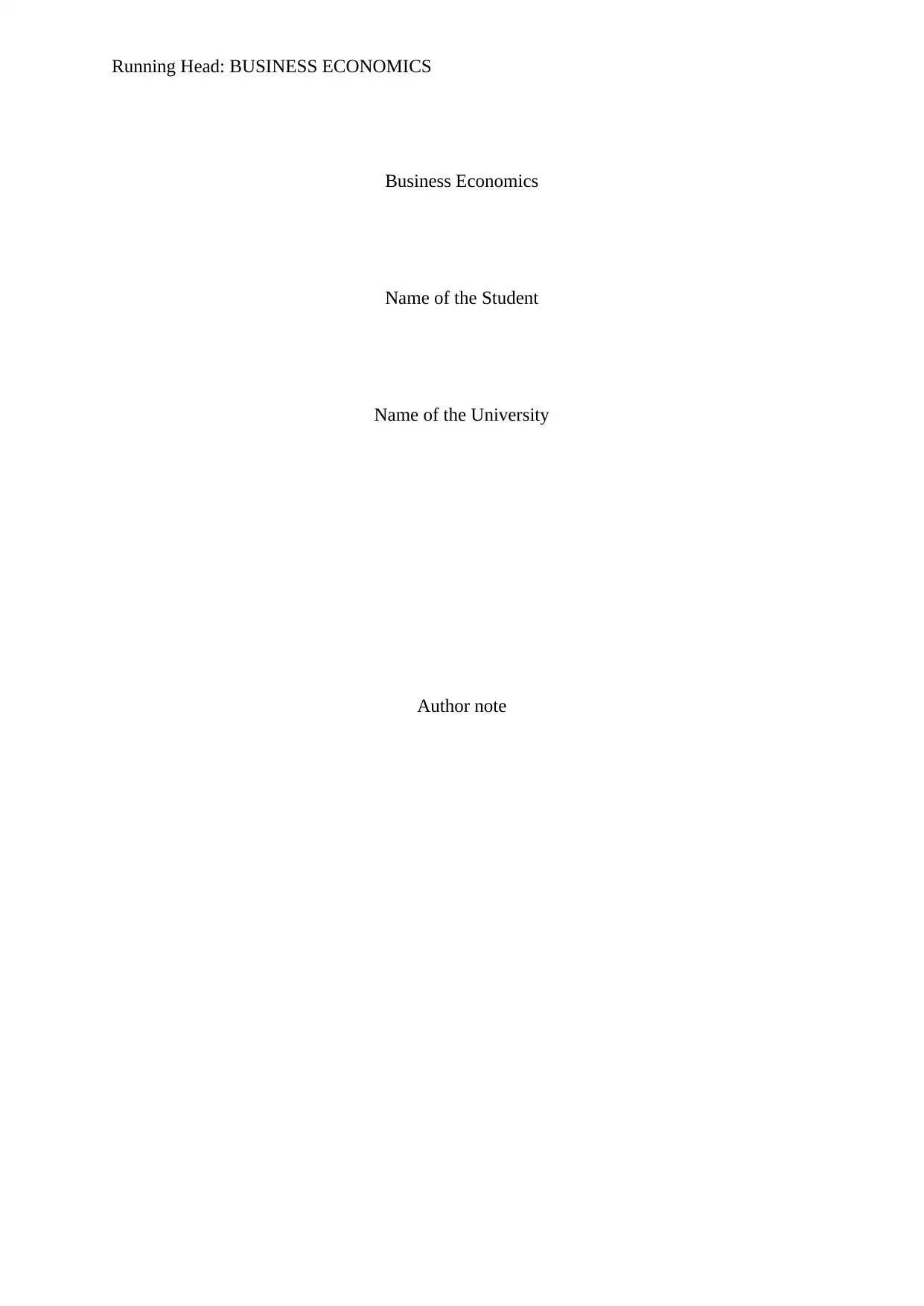
Running Head: BUSINESS ECONOMICS
Business Economics
Name of the Student
Name of the University
Author note
Business Economics
Name of the Student
Name of the University
Author note
Paraphrase This Document
Need a fresh take? Get an instant paraphrase of this document with our AI Paraphraser
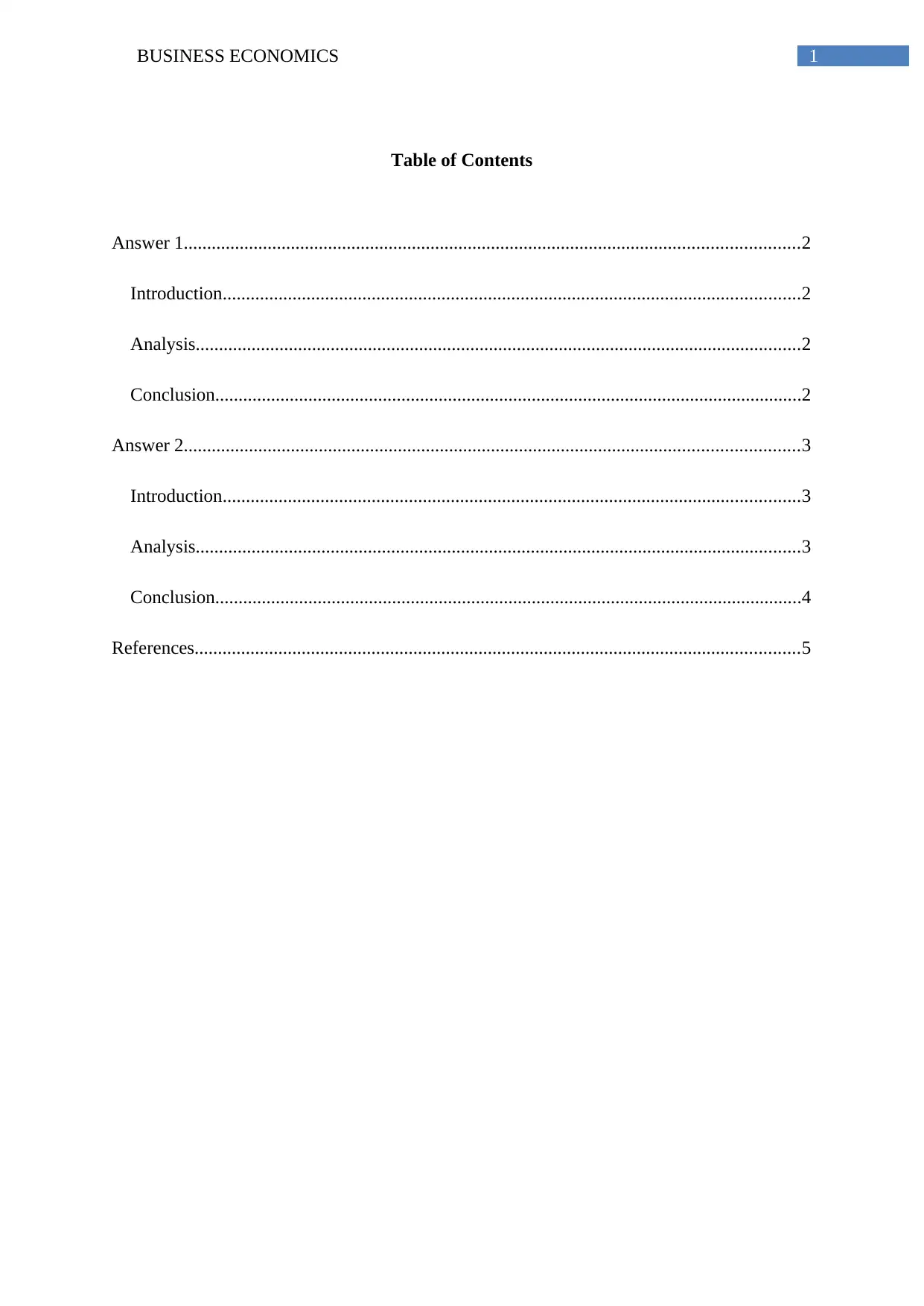
1BUSINESS ECONOMICS
Table of Contents
Answer 1....................................................................................................................................2
Introduction............................................................................................................................2
Analysis..................................................................................................................................2
Conclusion..............................................................................................................................2
Answer 2....................................................................................................................................3
Introduction............................................................................................................................3
Analysis..................................................................................................................................3
Conclusion..............................................................................................................................4
References..................................................................................................................................5
Table of Contents
Answer 1....................................................................................................................................2
Introduction............................................................................................................................2
Analysis..................................................................................................................................2
Conclusion..............................................................................................................................2
Answer 2....................................................................................................................................3
Introduction............................................................................................................................3
Analysis..................................................................................................................................3
Conclusion..............................................................................................................................4
References..................................................................................................................................5
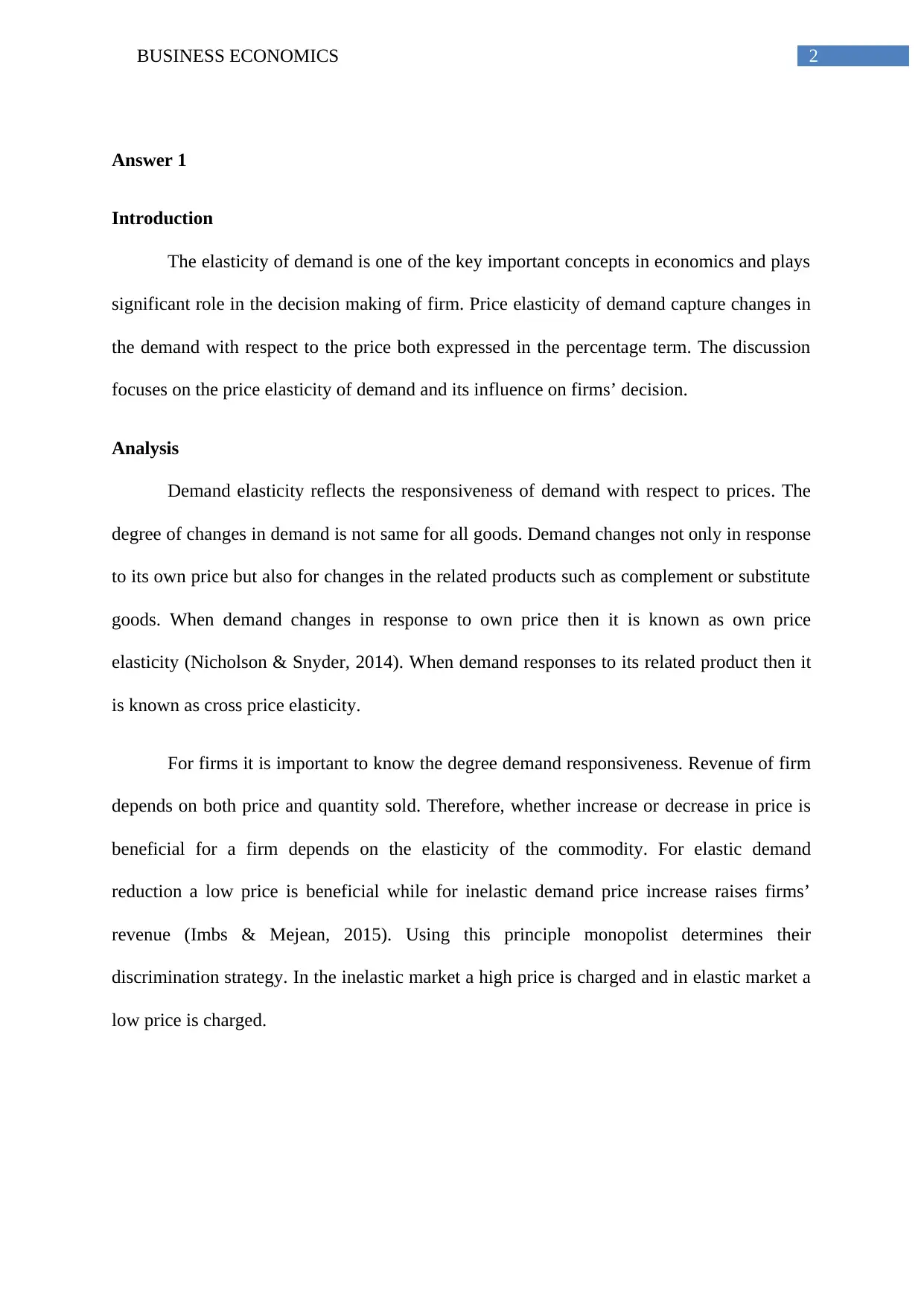
2BUSINESS ECONOMICS
Answer 1
Introduction
The elasticity of demand is one of the key important concepts in economics and plays
significant role in the decision making of firm. Price elasticity of demand capture changes in
the demand with respect to the price both expressed in the percentage term. The discussion
focuses on the price elasticity of demand and its influence on firms’ decision.
Analysis
Demand elasticity reflects the responsiveness of demand with respect to prices. The
degree of changes in demand is not same for all goods. Demand changes not only in response
to its own price but also for changes in the related products such as complement or substitute
goods. When demand changes in response to own price then it is known as own price
elasticity (Nicholson & Snyder, 2014). When demand responses to its related product then it
is known as cross price elasticity.
For firms it is important to know the degree demand responsiveness. Revenue of firm
depends on both price and quantity sold. Therefore, whether increase or decrease in price is
beneficial for a firm depends on the elasticity of the commodity. For elastic demand
reduction a low price is beneficial while for inelastic demand price increase raises firms’
revenue (Imbs & Mejean, 2015). Using this principle monopolist determines their
discrimination strategy. In the inelastic market a high price is charged and in elastic market a
low price is charged.
Answer 1
Introduction
The elasticity of demand is one of the key important concepts in economics and plays
significant role in the decision making of firm. Price elasticity of demand capture changes in
the demand with respect to the price both expressed in the percentage term. The discussion
focuses on the price elasticity of demand and its influence on firms’ decision.
Analysis
Demand elasticity reflects the responsiveness of demand with respect to prices. The
degree of changes in demand is not same for all goods. Demand changes not only in response
to its own price but also for changes in the related products such as complement or substitute
goods. When demand changes in response to own price then it is known as own price
elasticity (Nicholson & Snyder, 2014). When demand responses to its related product then it
is known as cross price elasticity.
For firms it is important to know the degree demand responsiveness. Revenue of firm
depends on both price and quantity sold. Therefore, whether increase or decrease in price is
beneficial for a firm depends on the elasticity of the commodity. For elastic demand
reduction a low price is beneficial while for inelastic demand price increase raises firms’
revenue (Imbs & Mejean, 2015). Using this principle monopolist determines their
discrimination strategy. In the inelastic market a high price is charged and in elastic market a
low price is charged.
⊘ This is a preview!⊘
Do you want full access?
Subscribe today to unlock all pages.

Trusted by 1+ million students worldwide
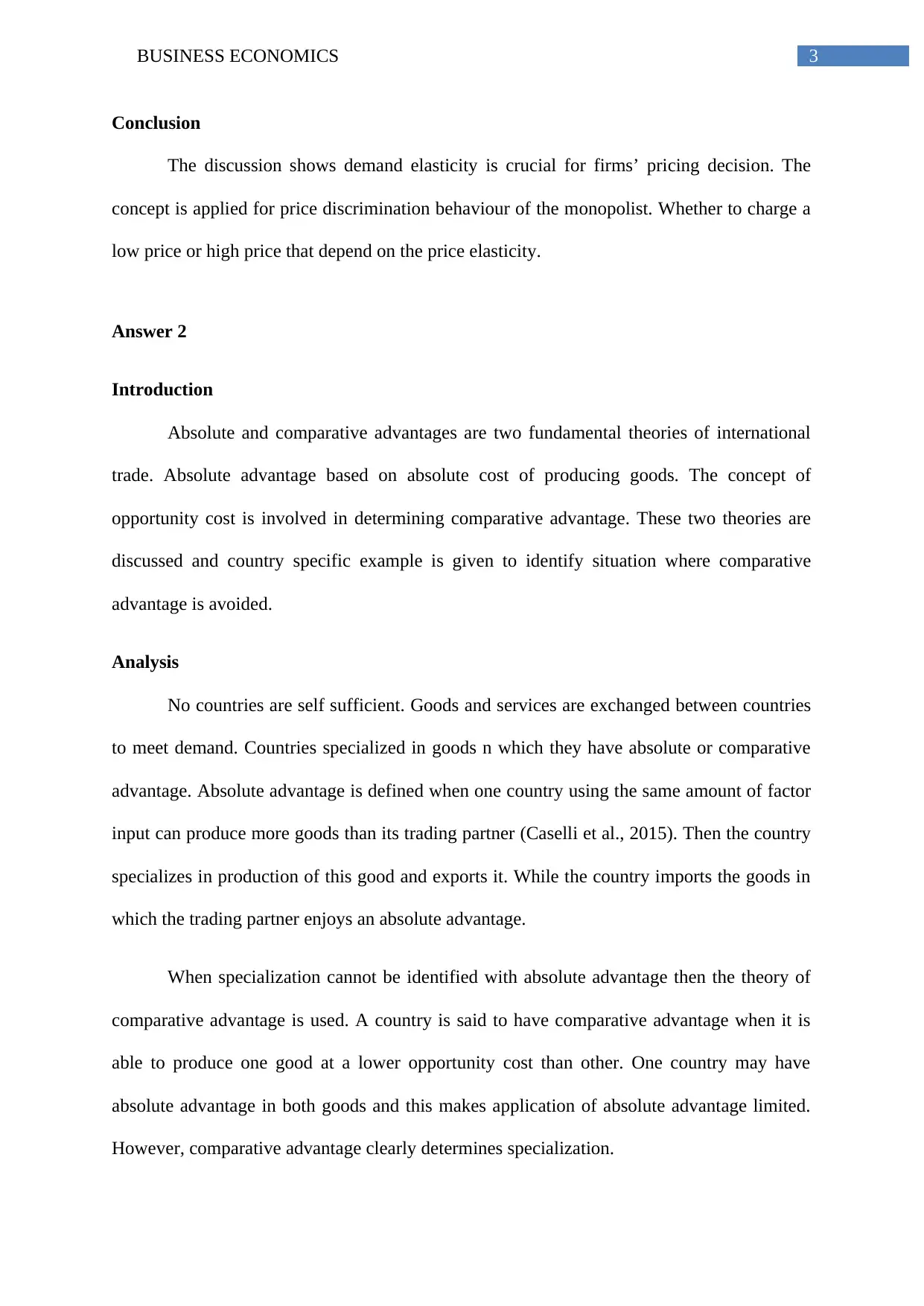
3BUSINESS ECONOMICS
Conclusion
The discussion shows demand elasticity is crucial for firms’ pricing decision. The
concept is applied for price discrimination behaviour of the monopolist. Whether to charge a
low price or high price that depend on the price elasticity.
Answer 2
Introduction
Absolute and comparative advantages are two fundamental theories of international
trade. Absolute advantage based on absolute cost of producing goods. The concept of
opportunity cost is involved in determining comparative advantage. These two theories are
discussed and country specific example is given to identify situation where comparative
advantage is avoided.
Analysis
No countries are self sufficient. Goods and services are exchanged between countries
to meet demand. Countries specialized in goods n which they have absolute or comparative
advantage. Absolute advantage is defined when one country using the same amount of factor
input can produce more goods than its trading partner (Caselli et al., 2015). Then the country
specializes in production of this good and exports it. While the country imports the goods in
which the trading partner enjoys an absolute advantage.
When specialization cannot be identified with absolute advantage then the theory of
comparative advantage is used. A country is said to have comparative advantage when it is
able to produce one good at a lower opportunity cost than other. One country may have
absolute advantage in both goods and this makes application of absolute advantage limited.
However, comparative advantage clearly determines specialization.
Conclusion
The discussion shows demand elasticity is crucial for firms’ pricing decision. The
concept is applied for price discrimination behaviour of the monopolist. Whether to charge a
low price or high price that depend on the price elasticity.
Answer 2
Introduction
Absolute and comparative advantages are two fundamental theories of international
trade. Absolute advantage based on absolute cost of producing goods. The concept of
opportunity cost is involved in determining comparative advantage. These two theories are
discussed and country specific example is given to identify situation where comparative
advantage is avoided.
Analysis
No countries are self sufficient. Goods and services are exchanged between countries
to meet demand. Countries specialized in goods n which they have absolute or comparative
advantage. Absolute advantage is defined when one country using the same amount of factor
input can produce more goods than its trading partner (Caselli et al., 2015). Then the country
specializes in production of this good and exports it. While the country imports the goods in
which the trading partner enjoys an absolute advantage.
When specialization cannot be identified with absolute advantage then the theory of
comparative advantage is used. A country is said to have comparative advantage when it is
able to produce one good at a lower opportunity cost than other. One country may have
absolute advantage in both goods and this makes application of absolute advantage limited.
However, comparative advantage clearly determines specialization.
Paraphrase This Document
Need a fresh take? Get an instant paraphrase of this document with our AI Paraphraser
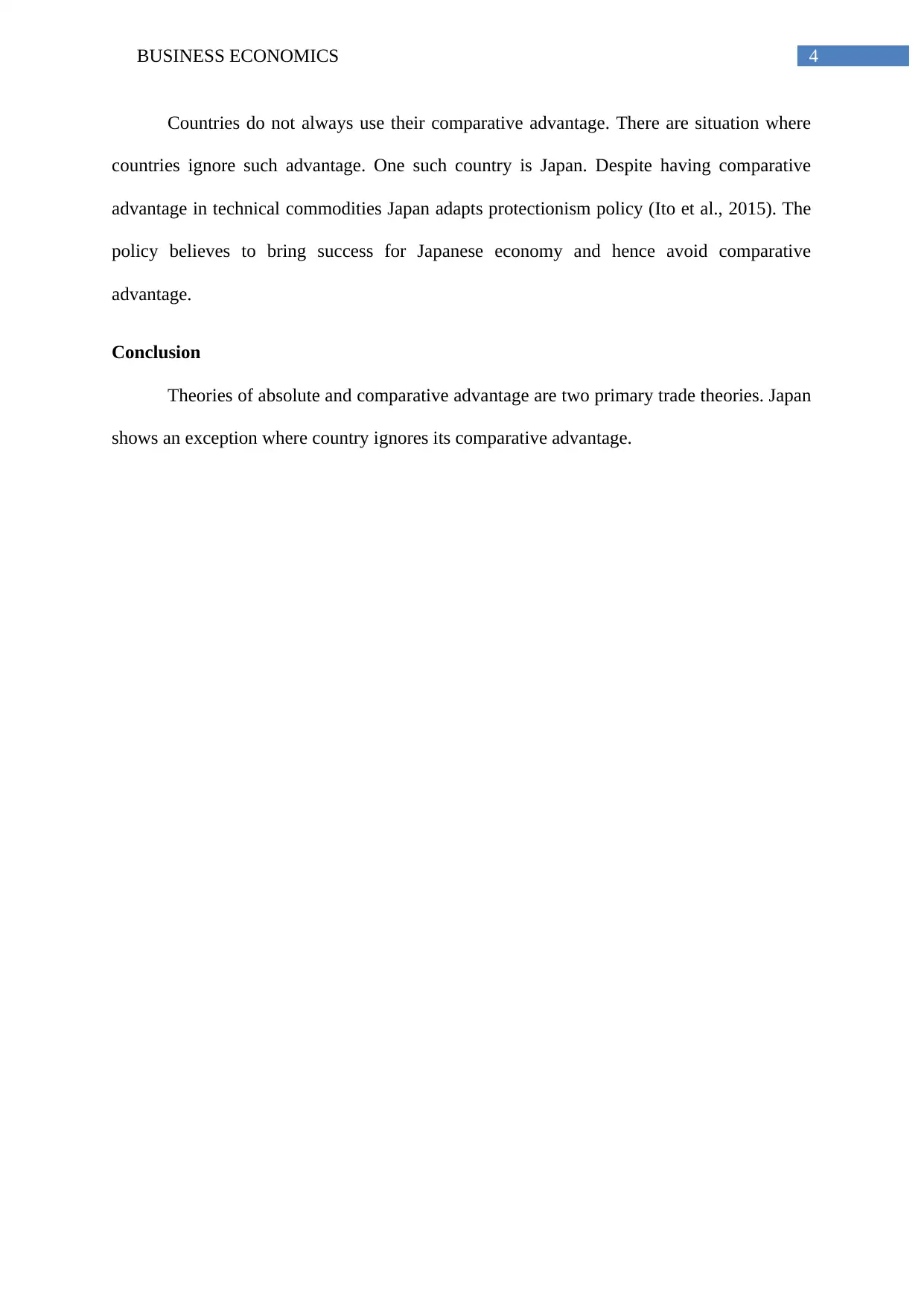
4BUSINESS ECONOMICS
Countries do not always use their comparative advantage. There are situation where
countries ignore such advantage. One such country is Japan. Despite having comparative
advantage in technical commodities Japan adapts protectionism policy (Ito et al., 2015). The
policy believes to bring success for Japanese economy and hence avoid comparative
advantage.
Conclusion
Theories of absolute and comparative advantage are two primary trade theories. Japan
shows an exception where country ignores its comparative advantage.
Countries do not always use their comparative advantage. There are situation where
countries ignore such advantage. One such country is Japan. Despite having comparative
advantage in technical commodities Japan adapts protectionism policy (Ito et al., 2015). The
policy believes to bring success for Japanese economy and hence avoid comparative
advantage.
Conclusion
Theories of absolute and comparative advantage are two primary trade theories. Japan
shows an exception where country ignores its comparative advantage.
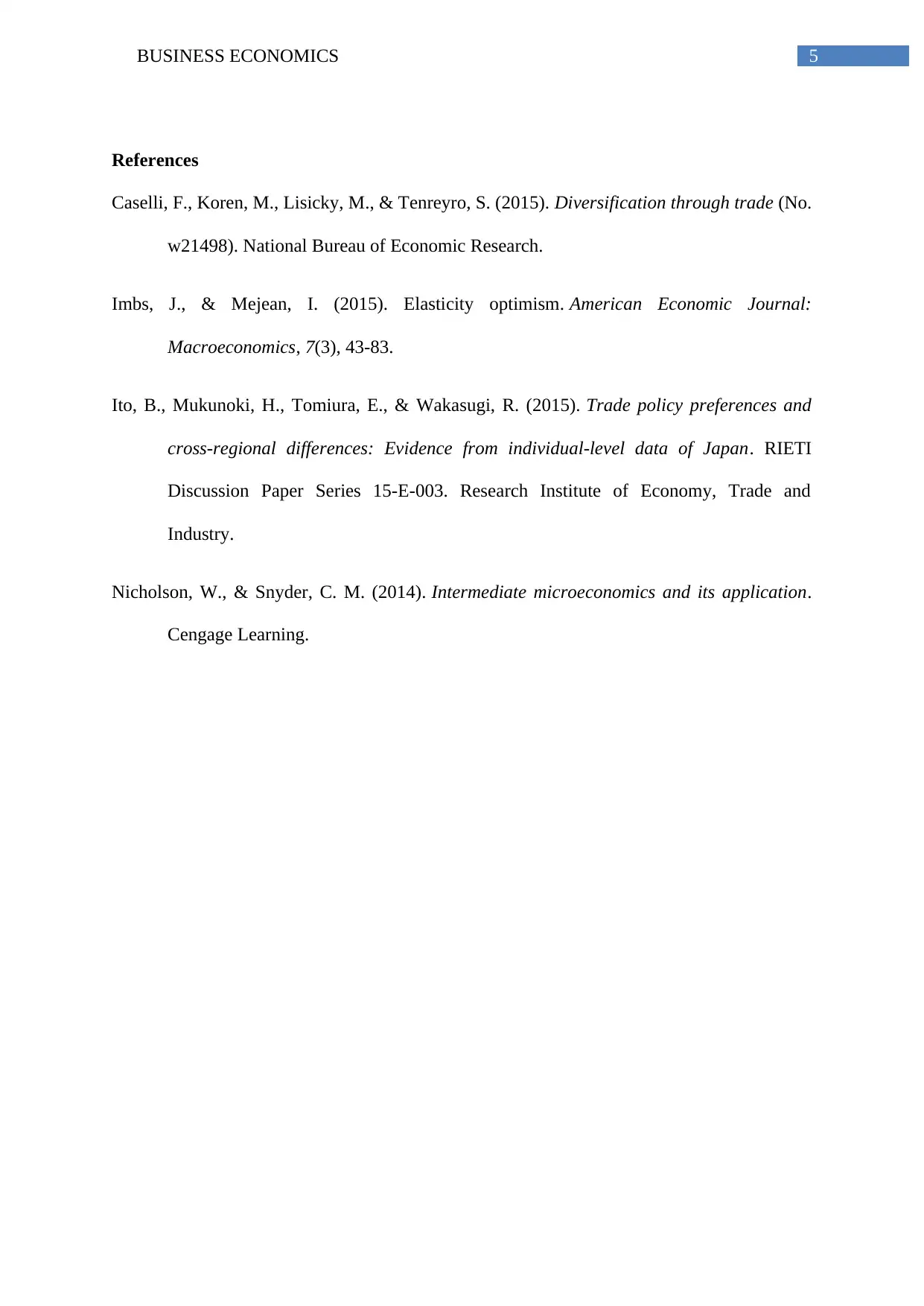
5BUSINESS ECONOMICS
References
Caselli, F., Koren, M., Lisicky, M., & Tenreyro, S. (2015). Diversification through trade (No.
w21498). National Bureau of Economic Research.
Imbs, J., & Mejean, I. (2015). Elasticity optimism. American Economic Journal:
Macroeconomics, 7(3), 43-83.
Ito, B., Mukunoki, H., Tomiura, E., & Wakasugi, R. (2015). Trade policy preferences and
cross-regional differences: Evidence from individual-level data of Japan. RIETI
Discussion Paper Series 15-E-003. Research Institute of Economy, Trade and
Industry.
Nicholson, W., & Snyder, C. M. (2014). Intermediate microeconomics and its application.
Cengage Learning.
References
Caselli, F., Koren, M., Lisicky, M., & Tenreyro, S. (2015). Diversification through trade (No.
w21498). National Bureau of Economic Research.
Imbs, J., & Mejean, I. (2015). Elasticity optimism. American Economic Journal:
Macroeconomics, 7(3), 43-83.
Ito, B., Mukunoki, H., Tomiura, E., & Wakasugi, R. (2015). Trade policy preferences and
cross-regional differences: Evidence from individual-level data of Japan. RIETI
Discussion Paper Series 15-E-003. Research Institute of Economy, Trade and
Industry.
Nicholson, W., & Snyder, C. M. (2014). Intermediate microeconomics and its application.
Cengage Learning.
⊘ This is a preview!⊘
Do you want full access?
Subscribe today to unlock all pages.

Trusted by 1+ million students worldwide
1 out of 6
Related Documents
Your All-in-One AI-Powered Toolkit for Academic Success.
+13062052269
info@desklib.com
Available 24*7 on WhatsApp / Email
![[object Object]](/_next/static/media/star-bottom.7253800d.svg)
Unlock your academic potential
Copyright © 2020–2025 A2Z Services. All Rights Reserved. Developed and managed by ZUCOL.





